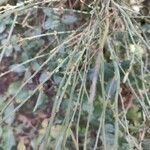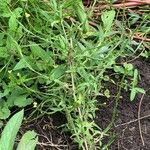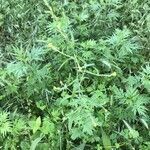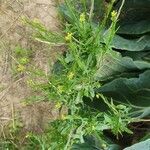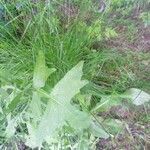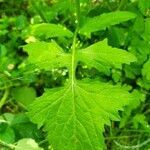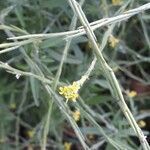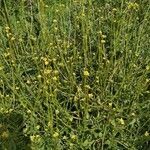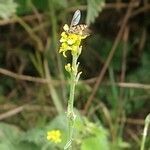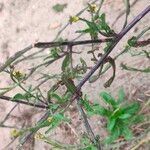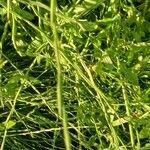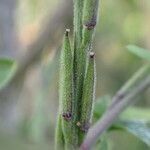Annuals; glabrous or pubescent. Stems erect, branched distally, 2.5-7.5(-11) dm, usually sparsely to densely hirsute, (trichomes retrorse), rarely glabrate distally. Basal leaves usually rosulate; petiole (1-)2-7(-10) cm; blade broadly oblanceolate or oblong-obovate (in outline), (2-)3-10(-15) cm × (10-)20-50 (-80) mm, margins lyrate-pinnatifid, pinnatisect, or runcinate; lobes (2)3 or 4(5) on each side, oblong or lanceolate, smaller than terminal lobe, margins entire, dentate, or lobed, (terminal lobe suborbicular or deltate, margins dentate). Cauline leaves similar to basal; blade with lobe margins dentate or subentire. Fruiting pedicels erect, (appressed to rachis), stout, narrower than fruit, 1.5-3(-4) mm. Flowers: sepals erect, oblong-ovate, 2-2.5 × ca. 1 mm; petals spatulate, 2.5-4 × 1-2 mm, claw 1-2 mm; filaments (erect, yellowish), 2-3 mm; anthers ovate, 0.3-0.5 mm. Fruits (erect), subulate-linear, straight, slightly torulose or smooth, stout, (0.7-)1-1.4(-1.8) cm × 1-1.5 mm; valves glabrous or pubescent; ovules 10-20 per ovary; style (0.8-)1-1.5 (-2) mm; stigma slightly 2-lobed. Seeds 1-1.3 × 0.5-0.6 mm. 2n = 14.
Annual or biennial herbs up to 90 cm high. Stems stiff, erect with wide-spreading, almost horizontal branches; stem and branches scabro-puberulous, the hairs short, coarse, reflexed, appressed, mostly thicker at the base. Basal leaves approximate or rosulate, petiolate, runcinate-pinnatisect, 3-7-jugate, the lobes opposite or alternate; lowest lobes narrow, subentire, upper lobes broadest, dentate; terminal lobe biggest, ±3-lobed, dentate. Stem leaves gradually reduced in size and in number of lobes, the uppermost petiolate, hastate, with a narrowly oblong-elliptic, irregularly dentate-lobate to entire terminal lobe and two small oblong or linear-oblong lateral lobes; all leaves strigose on both surfaces, the lower leaves eventually glabrescent. Racemes terminal, at first densely corymbose, in fruit strongly elongate. Flowers small, the sepals hairy. Petals 2.5-3.8 mm long, narrowly obovate, cuneate, yellow. Siliquae 1-1.5 cm long (including the style), subterete, stoutly subulate, erect on stout, appressed, 1-3 mm long pedicels; valves 1.nerved, rounded, densely puberulous. Seeds c. 1 mm long, oblong, brown.
Annual herb. Stem erect, hairy, to 1 m tall. Lvs and petioles with fine stiff hairs. Rosette lvs deeply lyrate-pinnatifid to lyrate-pinnate, (3)-7-25-(30) × (1.5)-2-9-(12) cm; terminal leaflet not lobed or 2-3-lobed, broadly toothed, ovate to reniform; lateral leaflets in 2-6 pairs, ± deflexed, triangular. Upper stem lvs smaller, deeply lyrate-pinnatifid to lyrate-pinnate; terminal leaflet narrow-oblong; lateral leaflets in 1-2 pairs, spreading or ± deflexed. Uppermost stem lvs becoming simple and hastate to narrow-triangular. Racemes ebracteate, suberect to spreading, hairy, (10)-20-30-(40) cm long. Pedicels c. 3 mm long, hairy. Sepals hairy, c. 2 mm long, not horned. Petals yellow, 3-4 mm long. Anthers c. 0.5 mm long; filaments > sepals. Silique hairy or glabrous, appressed to stem, tapering evenly from base, 10-15-(20) × 1-2 mm; style c. 0.5 mm long. Seeds oblong, brown, c. 1 mm long.
Annual or biennial herb, 20–100 cm. high.. Stems erect, stiff, upwards with divaricate nearly horizontal branches, hispid with short retrorse hairs.. Basal leaves with long petioles, lyrate-pinnate, with 2–3 pairs of lateral and an acutely triangular to hastate terminal lobe; upper leaves shortly petioled, lyrate-pinnate to narrowly hastate, with 0–2 pairs of lateral lobes; all leaves irregularly and coarsely dentate, ± strigose.. Racemes with numerous small flowers, in fruit very elongate; pedicels erect, adpressed to the axis, thick, 2–4 mm. long, and with erect siliquae.. Sepals hairy, ± 2 mm. long.. Petals yellow, obovate, cuneate, 2.5–4 mm. long.. Siliqua narrowly conical, 10–18 mm. long, 1–1.5 mm. broad at the base; valves usually finely hispid; style ± 0.5 mm. long.. Seeds brown, oblong in outline, ± 1 mm. long.
Annual or biennial herb, 0.5-0.9 m high, erect. Stems and branches scabro-puberulous. Leaves: basal leaves rosulate, petiolate, runcinate-pinnatisect, 3-7-jugate, lobes opposite or alternate, lower lobes narrow, subentire, upper lobes broadest, dentate, terminal lobe biggest, 3-lobed, dentate; uppermost cauline leaves petiolate, hastate, oblong-elliptic, irregularly dentate-lobate to entire, terminal lobe and 2 lateral lobes oblong or linear-oblong, strigose on both surfaces. Inflorescence a terminal raceme. Sepals hairy. Petals narrowly obovate, cuneate, yellow. Fruit a siliqua, subterete, erect on stout pedicels. Seeds oblong, brown.
Annual or biennial herb to 90 cm high, erect, hispid; hairs reflexed. Rosette leaves deeply pinnatifid with 3–5 pairs of lobes, petiolate, dentate; cauline leaves reducing. Inflorescence branches rigid, at 90° to main axis. Sepals erect, 2–2.5 mm long. Petals 2–4 mm long, pale yellow. Style 0.5–1 mm long. Siliqua conical, 8–20 mm long, 2 mm wide at base, straight, attenuate to style; pedicels stout, 1–2 mm long, appressed to stem and holding siliqua appressed to stem. Seeds ellipsoidal-ovoid, c. 1.5 mm long.
Erect, 3–8 dm; lower lvs petioled, deeply pinnatifid, the segments oblong to ovate or the terminal one rotund, angularly toothed, upper lvs sessile or nearly so and often entire; pet light yellow, 3–4 mm; racemes stiffly erect, the mature pedicels closely appressed, 2–3 mm, thickened above; frs closely appressed, subulate, 8–15 mm, 1–1.5 mm wide at base; 2n=14. Native of Eurasia, commonly established as a weed throughout most of the U.S. May–Sept.
A cabbage family herb. It is an erect annual plant. It grows 25-75 cm tall. It is mostly smooth. The branches are almost at right angles to the stem. The leaves form a ring at the base. The leaves are divided with the lobe at the end being the largest. The upper leaves are smaller. They have 2 lobes at the base. The flowers are pale yellow. The pods are 2.5-5 cm long and about 1 mm wide. They are ribbed and hairy.
Annual or biennial herb, up to 0.9 m high, with simple hairs. Inflorescence ebracteate. Siliqua stoutly subulate, tapering, puberulous. Flowers yellow.
